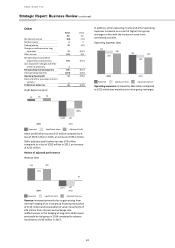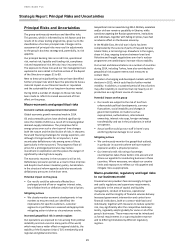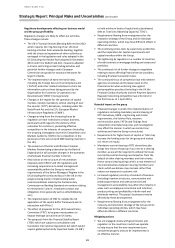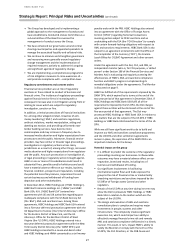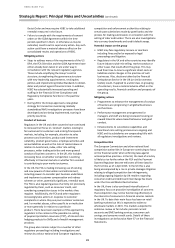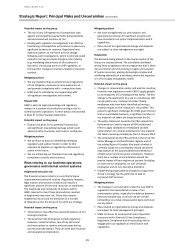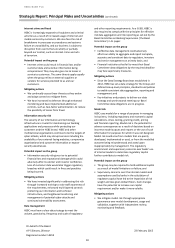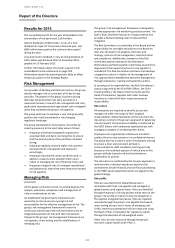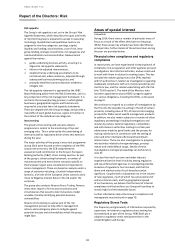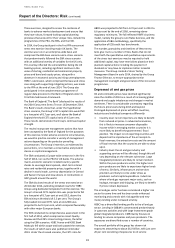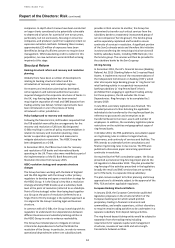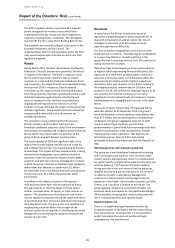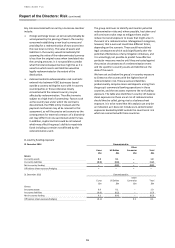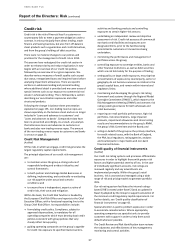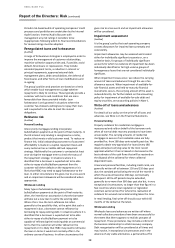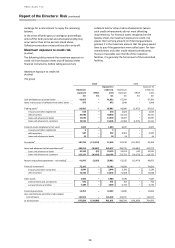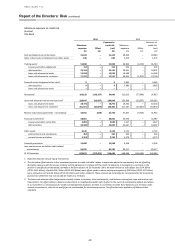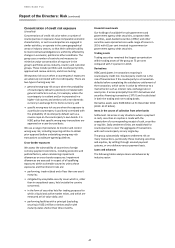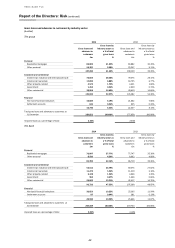HSBC 2014 Annual Report Download - page 36
Download and view the complete annual report
Please find page 36 of the 2014 HSBC annual report below. You can navigate through the pages in the report by either clicking on the pages listed below, or by using the keyword search tool below to find specific information within the annual report.
HSBC BANK PLC
Report of the Directors: Risk (continued)
34
companies. In-depth client reviews have been conducted
on larger clients considered to be potentially vulnerable
to depressed oil prices for a period of one to two years,
particularly, but not exclusively, focusing on oil service
companies, and producers (and their suppliers) reliant on
expensive extraction methods. Following these reviews,
approximately £35 million of exposures have been
identified as being of sufficient concern to require close
management. Whilst weakening credit is evident in this
population, no new customers were identified as being
impaired at this stage.
Structural Reform
Banking structural reform and recovery and resolution
planning
Globally there have been a number of developments
relating to banking structural reform and the
introduction of recovery and resolution regimes.
As recovery and resolution planning has developed,
some regulators and national authorities have also
required changes to the corporate structures of banks. In
the UK, ring-fencing legislation has been enacted
requiring the separation of retail and SME deposits from
trading activity (see below). Similar requirements have
been introduced or are in the process of being
introduced in other jurisdictions.
Policy background to recovery and resolution
Following the financial crisis, G20 leaders requested that
the FSB establish more effective arrangements for the
recovery and resolution of 28 (now 30) designated
G-SIBs resulting in a series of policy recommendations in
relation to recovery and resolution planning, cross
border co-operation agreements and measures to
mitigate obstacles to resolution. The HSBC Group has
been designated as a G-SIB.
In December 2013, the PRA set out rules for recovery
and resolution of UK banks and international banks
operating in the UK. These rules were modified as part of
the implementation of the EU Bank Recovery and
Resolution Directive from January 2015.
HSBC resolution strategy and corporate structure
changes
The Group has been working with the Bank of England
and the PRA together with the Group’s other primary
regulators to develop and agree a resolution strategy for
the HSBC Group. It is the Group’s view that a resolution
strategy whereby HSBC breaks up at a subsidiary bank
level at the point of resolution (referred to as a Multiple
Point of Entry strategy) rather than being kept together
as a Group at the point of resolution (referred to as a
Single Point of Entry strategy) is the optimal approach as
it is aligned to the Group’s existing legal and business
structure.
In common with all G-SIBs, the Group is working with its
regulators to understand inter-dependencies between
different businesses and subsidiary banking entities in
the HSBC Group in order to enhance resolvability.
The Group has initiated plans to mitigate or remove
critical inter-dependencies to further facilitate the
resolution of the Group. In particular, in order to remove
operational dependencies where one subsidiary bank
provides critical services to another, the Group has
determined to transfer such critical services from the
subsidiary banks to a separately incorporated group of
service companies (‘ServCo group’). The ServCo group
will be separately capitalised and funded to ensure
continuity of services in resolution. A significant portion
of the ServCo already exists and therefore this initiative
involves transferring the remaining critical services still
held by subsidiary banks, including HSBC Bank plc, into
the ServCo group. The services will then be provided to
the subsidiary banks by the ServCo group
UK ring-fencing
In December 2013, the UK’s Financial Services (Banking
Reform) Act 2013 (‘Banking Reform Act’) received Royal
Assent. It implements most of the recommendations of
the Independent Commission on Banking (‘ICB’), which
inter alia require large banking groups to ‘ring-fence’ UK
retail banking activity in a separately incorporated
banking subsidiary (a ‘ring-fenced bank’) that is
prohibited from engaging in significant trading activity.
For these purposes, the UK excludes the Crown
Dependencies. Ring-fencing is to be completed by 1
January 2019.
In July 2014, secondary legislation was finalised. This
included provisions further detailing the applicable
individuals to be transferred to the ring-fenced bank by
reference to gross worth and enterprises to be
transferred based on turnover, assets and number of
employees. In addition, the secondary legislation places
restrictions on the activities and geographical scope of
ring-fenced banks.
In October 2014, the PRA published a consultation paper
on ring-fencing rules in relation to legal structure,
governance, and continuity of services and facilities. The
PRA intends to undertake further consultations and
finalise ring-fencing rules in due course. The PRA also
published a discussion paper concerning operational
continuity in resolution.
As required by the PRA’s consultation paper, the Group
presented a provisional ring-fencing project plan to the
UK regulators in November 2014. This plan provided for
ring-fencing of the activities prescribed in the legislation,
broadly the retail and SME services that are currently
part of the bank, in a separate Group subsidiary.
The plan remains subject to further planning and Group
approvals and is ultimately subject to the approval of the
PRA, FCA and other applicable regulators.
European Banking Structural Reform
In January 2014, the European Commission published
legislative proposals on the structural reform of the
European banking sector which would prohibit
proprietary trading in financial instruments and
commodities, and enable supervisors, at their discretion,
to require certain trading activities to be undertaken in a
separate subsidiary from deposit taking activities.
The ring-fenced deposit taking entity would be subject to
separation from the trading entity including
requirements for separate capital and management
structures, issuance of own debt and arms-length
transactions between entities.


